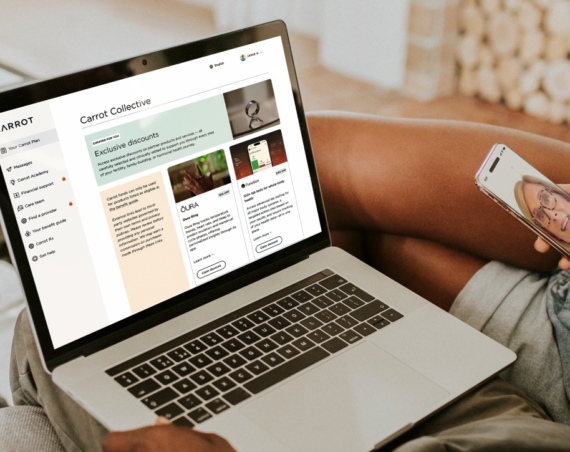
At HLTH this week, Jessica Federer stood on the main stage and declared that the time for incrementalism in women’s health is over. The founder and managing partner of The Women’s Health Fund announced a new vehicle designed not just to invest in women’s health companies, but to systematically build a market that has been under-recognized, under-funded, and under-prioritized.
“We didn’t include women in clinical trials until 1993. We didn’t study women. We don’t have enough data on women,” Federer told the audience. “We owe women decades of scientific advancement, and now it’s time to deliver.”
The Women’s Health Fund brings together managers with an anticipated $60 billion in assets under management, aiming to channel more of that capital into women’s health ventures. Founding supporters include The American Heart Association Go Red for Women Venture Fund, the Society for Women’s Health Research, 1843 Capital, Pontiva Healthcare Partners, Shaper Capital, Women’s Health Access Matters, and other industry leaders.
The flagship vehicle, WH1, is structured as a life sciences-focused fund of funds backing experienced managers seeking to expand their women’s health portfolios.
Building a Market
The fund addresses a systemic problem: many established life sciences funds have the expertise and capital to invest in women’s health innovation, but the category hasn’t been a strategic priority. A few years ago, the largest dedicated fund in women’s health was only $40 million. Since Federer launched the Health of Women Investor Summit in 2023, the market has seen a 6x increase in funds, with two $250 million funds announced this year alone.
The Women’s Health Fund’s fund of funds model plans to invest in 15 top-performing life sciences funds with experienced managers who can take companies from Series A through exit, maturing the market faster than waiting for incremental growth. The approach mirrors how other markets have been built – it requires more than individual players, it needs infrastructure and coordination across pharma, biotech, medical device companies, philanthropic foundations, governments, and academia.
The fund is designed for sustainable growth, not hype cycles. “We’re not looking for what we saw in cell and gene therapy or digital health, where investment levels went to places they shouldn’t have been,” Federer said. “We’re looking to have evidence-based sustainable growth, because half of the population is waiting for us.”
The Economic Case
Dr. Lucy Pérez, senior partner with McKinsey and Global Leader of the McKinsey Health Institute, presented research showing women spend 25% more time in poor health than men, primarily during their prime working years between ages 20 and 60.
“We found that closing this gap could add over a trillion dollars in GDP contributions each year,” Pérez said during the panel discussion. “Take endometriosis or polycystic ovarian syndrome – conditions that impact 1 in 10 women. These could be $200 billion markets each.”
The opportunity extends beyond conditions specific to women. For diseases like asthma and cardiovascular disease that affect both sexes, about a third of the market remains untapped because research and treatment don’t account for sex-based differences.
“This is not charity,” Pérez emphasized. “This is about really smart, evidence-based investments in an area of untapped growth potential.”
Investment in women’s health has grown approximately 50% from 2023 to 2024, reaching $2.6 billion, with major players like Pivotal Ventures, Wellcome Leap, and the Gates Foundation making significant commitments.
The Science Gap
Dr. Basmah Safdar, Director of Women’s Health Research at Yale and Founding Member of the Advisory Board for The Women’s Health Fund, explained how decades of excluding women from research created fundamental knowledge gaps.
“Every cell has a sex,” Safdar said, describing Yale’s work that has moved beyond studying women’s health as solely reproductive health. “We’re studying diseases that are disproportionate in women, like Alzheimer’s disease and mental health conditions, diseases that present differently in women, such as heart disease and cancer, and diseases specific to women, such as menopause and preeclampsia.”
Yale’s $6 million investment in women’s health research awards has generated $124 million in external funding and produced groundbreaking science. When COVID-19 emerged, Yale was first to show that immune responses differed between males and females – explaining why more men were dying from the disease.
“When you put that lens on women’s health, you’re not just improving the lives of women, but improving the lives of both men and women,” Safdar said.
Current research at Yale focuses on neuroscience and Alzheimer’s, autoimmune conditions, and vascular aging – exploring why women live longer than men but with poorer quality of life.
Strategic Investment
Tracy Warren, Senior Managing Director at the Go Red For Women Fund at the American Heart Association, described their approach as bridging seed-stage investments to later-stage capital.
“We’re looking at conditions that differently or disproportionately affect women, and treatments that affect and improve the lives of men and women,” Warren said. “The solutions we’re interested in don’t always treat just women – they address large markets with evidence-based science, meaningful impact, and scalable returns.”
The Go Red Fund is philanthropically supported rather than operating under typical 10-year fund pressures, allowing them to bring in family offices and wealthy individuals while activating the American Heart Association’s relationships with pharmaceutical, biotech, and device companies.
Warren invited all investors to consider themselves women’s health investors: “You don’t have just a lens of gender. You have a lens of equity and parity and high quality healthcare for all.”
Vision and Path Forward
The panelists outlined an aspirational future where women’s health becomes integrated into mainstream innovation rather than a separate category. Safdar pointed to current gaps in clinical practice: “When I’m working in the emergency department, if a man comes in with chest pain, I have tools to diagnose heart disease. But I still don’t have tools that will diagnose it in women, even though we know the biology is different.”
Pérez drew a parallel to GLP-1 drugs to illustrate the market potential: “1 in 10 have diabetes, 1 in 10 women have endometriosis. That gives me the confidence to believe that innovation directed towards women’s health can indeed be that next GLP-1 category.” Her aspiration is for sex-based differences to become the default question in research and care delivery.
The momentum is building. Because of the success of GLP-1s in the pharmaceutical industry, all major pharma and biotech players are now examining how sex-based differences impact drug discovery and development.
The panelists challenged the HLTH audience to get active themselves. Warren urged investors to look at existing portfolios for hidden opportunities. Safdar called for “reverse pitch” partnerships where industry comes to academia to identify unmet needs. The message was clear: this requires deliberate action across the entire ecosystem.
When asked what headline she wants to see at next year’s HLTH, Federer emphasized a fundamental shift: “For so long, we tried to reach the goal of equality, of treating men and women the same, and that was the wrong goal. That is not precision medicine, that is not evidence-based.”
Pérez closed by framing the stakes: “We’re not talking about a niche. We’re talking about 51% of the population. We’re talking about a trillion dollar-plus opportunity. We have the data and evidence that demonstrates that investing in women’s health is smart business.”
And that’s exactly what The Women’s Health Fund is designed to do – activate $60 billion in assets under management to prove that thesis and build the market infrastructure to sustain it.



